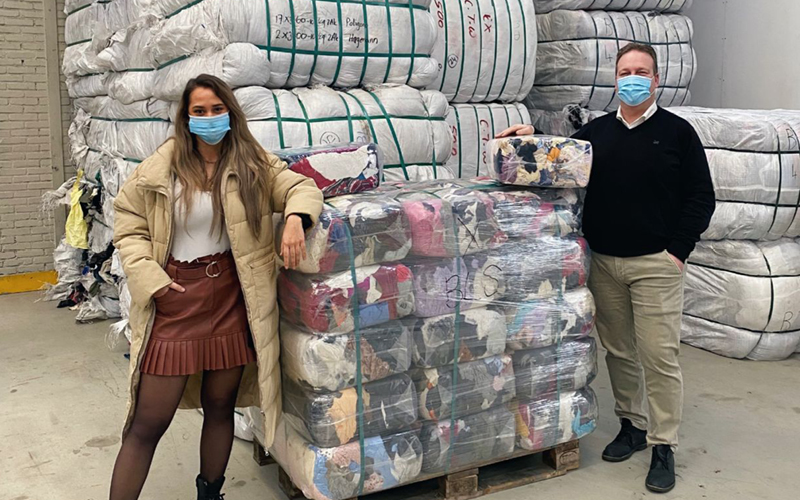Interview: Nico Bennik about our cleaning rags process, challenges and the future
“You may think producing a cleaning cloth is as easy as just popping the buttons off some old clothes. People don't realize that even a simple cleaning rag travels around the world before it is put into use.” Nico Bennik has been working at MTS Euro Products since 2006 and has taken charge of the entire cleaning rags department. What process does a garment go through before it can be used as a cleaning cloth? What challenges does COVID-19 pose? What distinguishes a cleaning cloth from a non-woven cloth? In this interview, I ask Nico Bennik all about it and learn more about our cleaning rags business.

How did you start at MTS Euro Products?
That's a funny story, as I was actually planning to quit the cleaning rags market. When Gerrit Malipaard became aware of this, he contacted me to ask if I was interested in an exciting position in the cleaning rags department. I went for it. At the time, we had set three objectives: to become big in cleaning rags, to professionalize the process and to become the main market player for cleaning rags in Europe. We have now achieved these three tasks, resulting in the beautiful process and product that we now offer. Now, in addition to sales, I am mainly involved in controlling the entire cleaning rags process. Our 3 production locations ensure that the right grade of cloth is cut and that the cleaning rags are packed according to our clients' wishes.

How exactly do we come by all of those cleaning cloths?
Our cleaning cloths are produced from 100% recycled textile. But before the large bales of cleaning rags are delivered to our warehouse, a lot has to happen. Collected old clothing is sold to sorting companies. These companies sort all clothing according to different cloth types. About 2000 kg is sorted per employee per day. Subsequently, all bins of sorted clothing either go through a second sorting process, or the clothing gets packaged. Some types of clothes are recycled for foam in seats, car materials or insulation material, for example. We buy the remaining clothing from these sorting companies. This amounts to around 17 to 20% of all old clothes that have been collected. The clothing that is still usable and that is sold as second-hand clothing is divided into two quality grades. Grade two is sent to, for example, Pakistan, India, Iraq and Iran. And then you have grade one, the cream of the crop. These clothes go to thrift stores in Europe.
The sorted clothes have been bought from the sorting companies. What's next?
The cleaning rags are sent in bales from the sorting companies to our cutting plants. Here the cleaning rags are cut into two types, namely white and colored cleaning rags. We call our colored cleaning rags 'variegated'. The variegated cleaning rags are again subdivided into tricot, fur rags, thick and thin terry cloth rags. The white cleaning rags are also subdivided in the same way. The buttons and zippers are removed with a special cutting technique. Every day, about 600 kilos of cloth are cut per person, in 40 different quality grades. The cut cloths are then packed in various sizes such as 1 kg, 5 kg, 10 kg, 25 kg or large bales and sent to 30 different countries in the world.
Does that mean you spend a lot of time on the road to visit clients or our factories? I'm usually gone about half the month. I visit our production locations or clients or suppliers. Unfortunately, this was not possible this year due to the COVID-19 outbreak. That has taken a lot of getting used to for me, but also for the home front. I'll be happy when everything opens up again and we can hit the road again. The online meetings are fun, sure. Sometimes you'll see a child running past in the background or someone with a cat on their lap. There are certainly nice memories of this time, but I still prefer to visit business relations in the flesh to discuss certain matters. When you are in a room together, you often come up with different possibilities and ideas. I miss the interaction in real life, stopping by to see one another, offering solutions and responding to one another. But at the moment, the most important thing is that everyone stays healthy, so we will keep doing the online meetings for a while. It is essential that we put health first now. That's the only way we will be able to safely travel to see one another again in the future. A time that I certainly look forward to.
Speaking of COVID-19, has this impacted our cleaning rags?
It started with Chinese New Year, which is known for slowing down industry in China. In 2020, the first lockdown hit Europe and China shortly after Chinese New Year. All industries in Europe closed and materials stopped coming our way from China. Our suppliers in Germany, France and Scandinavia closed the market, so that the wholesalers no longer sold anything. We immediately switched and adjusted our production capacity. In April, the exact opposite happened. China's industry reopened and the demand for cleaning rags became enormous. We have been very busy ever since.
That's pretty crazy because things are pretty quiet here in the Netherlands at the moment. Hospitality establishments are closed, many shops are still closed, and yet you are actually very busy?
Yes, that is very strange indeed. Many of us are currently limited to work and stay at home. However, if you look more closely, you will see a lot of freight traffic on the highways. And thank goodness, because this means that the economy is doing well. The next challenge is that a lot less clothes are sold now that all the shops are closed. If people buy less clothing, this also means that less clothing is thrown away and, in the long run, less clothing is available for the production of cleaning rags. Ultimately, this will result in fewer cleaning rags, while there is an enormous demand in industry, and our industrial clients still prefer cleaning rags to, say, non-woven cloths.
What exactly is the reason for that? What is the difference between a non-woven cloth and a cleaning cloth?
First of all, you can use a cleaning rag several times. It is not a roll or box will run out. and you can use a cleaning rag for a lot of different cleaning activities such as cleaning and absorbing. In addition, it is a sustainable product, in that a piece of clothing is given a second life. A non-woven cloth, on the other hand, is produced from new raw materials and is more suitable for small cleaning tasks, because their quality and size are always the same. A non-woven cloth is also always produced in the same way. In contrast, cleaning cloths are cut from old textile, the size and quality of which can differ. With a cleaning cloth, even the size of the cloth can differ. After all, each T-shirt is a different size, though we always aim to cut the patches to approximately 40x40cm. Both types of cloths have different properties and are suitable for different cleaning tasks.
What other changes has the cleaning rags market experienced in recent years?
So many! The changes depend whether economic conditions are good or bad. You wouldn't say it, but the cleaning rag industry depends on many different factors. The economic crisis, for example, meant that a lot less clothing was thrown away at the time. But nowadays, the clothing market has really become a consumer market, and people want to have new clothes to wear every month or season. For this reason, the supply of cheap clothing has increased, which is good for cleaning rags production.
The process of producing cleaning rags is a circular process and thus makes a positive contribution to the environment. Do you notice that your customers also feel this is an important consideration in their buying process?
It's twofold. We have many wholesalers as clients,and they buy our products because they have end users as customers who need them. They sometimes ask me if we have a sustainable solution for a certain application. On the other hand, we also supply a lot to importers who used to cut and pack cleaning rags themselves, but have stopped doing so because of the high costs. MTS Euro Products has decided to step into this niche and produce large bales. We now offer them a ready-made end product featuring an attractive (private) label. Every client is unique and has different requirements. For example, our clients in the Netherlands, Belgium and France want their deliveries in boxes, while our customers in Switzerland prefer to have their cleaning rags delivered in 5 kg bags. Scandinavia wants a lot of volume and therefore prefers 25 kg bags. The sustainability aspect of our cleaning rags is not as important for every client, but there are many clients who are paying more and more attention to it for marketing reasons.
What do you think the coming years will be like in the cleaning rags market?
I think the COVID-19 virus will always be with us, and that the new development of working from home will stick around, as companies have discovered a new way of working. So it all depends on the behavior of people themselves. Will people continue to buy more clothes than they need, or become more aware of their purchasing habits? Depending on these developments, more or fewer cleaning rags will be available. Secondly, everyone has also started to think differently about industry, the environment and sustainability.
People want to contribute to a sustainable world, more circular living and more conscious use of products. We also see this in the clothing industry. People recycle a lot more, which is good for the cleaning cloth market. In addition, the production process of clothing is becoming increasingly innovative. Different types of plastic are already being made using old clothes as the raw material. And the process of turning old clothes into new clothes is also becoming more advanced. These last two sustainable innovations are a threat to cleaning rags. Old clothing can be used for many more purposes these days, leaving less clothing for the cleaning rags industry, but on the other hand, these circular solutions do help the price development of cleaning rags and, of course, they are better for the environment. This last aspect is an important part that we must all pay attention to.
It can be concluded that the cleaning rags market is a very interesting market. A market that has seen many changes in recent years, but certainly still has plenty of challenges ahead. Thank you, Nico, for this instructive interview!
Want to stay informed about my blogs, vlogs and fun interviews? Let’s connect via LinkedIn
The latest updates

Dimensio Group joins forces with MTS Euro Products and Boso. The combination generates €300 million in revenue from hygiene and packaging solutions.
15-09-2025What does this mean in practice? For customers: access to a broader product range, from sustainable packaging to hygiene and cleaning products, supported by an international net...

Marcel van der Zwan new CEO MTS Euro Products B.V. | Founder/Majority shareholder Gerrit Malipaard takes advisory role
13-02-2025Gerrit Malipaard: ‘With Marcel, we deliberately brought in someone from our region. He was born in Maassluis and lives in Maasland. As a result, he knows Euro Products well,...
 NL
NL  EN
EN  DE
DE 







